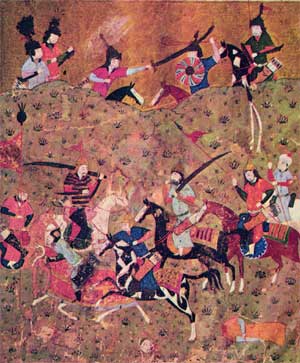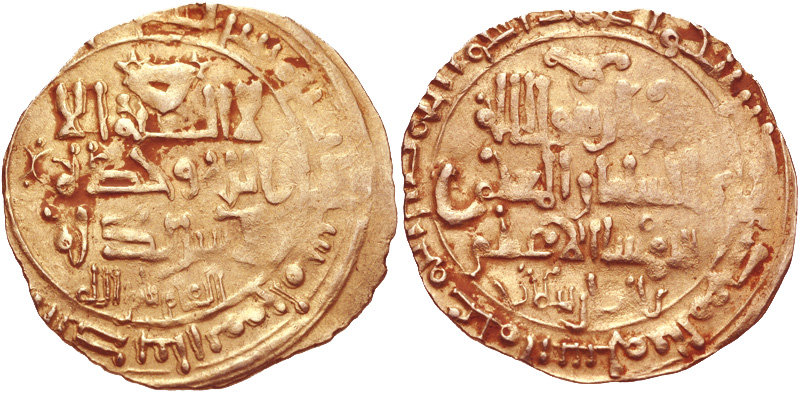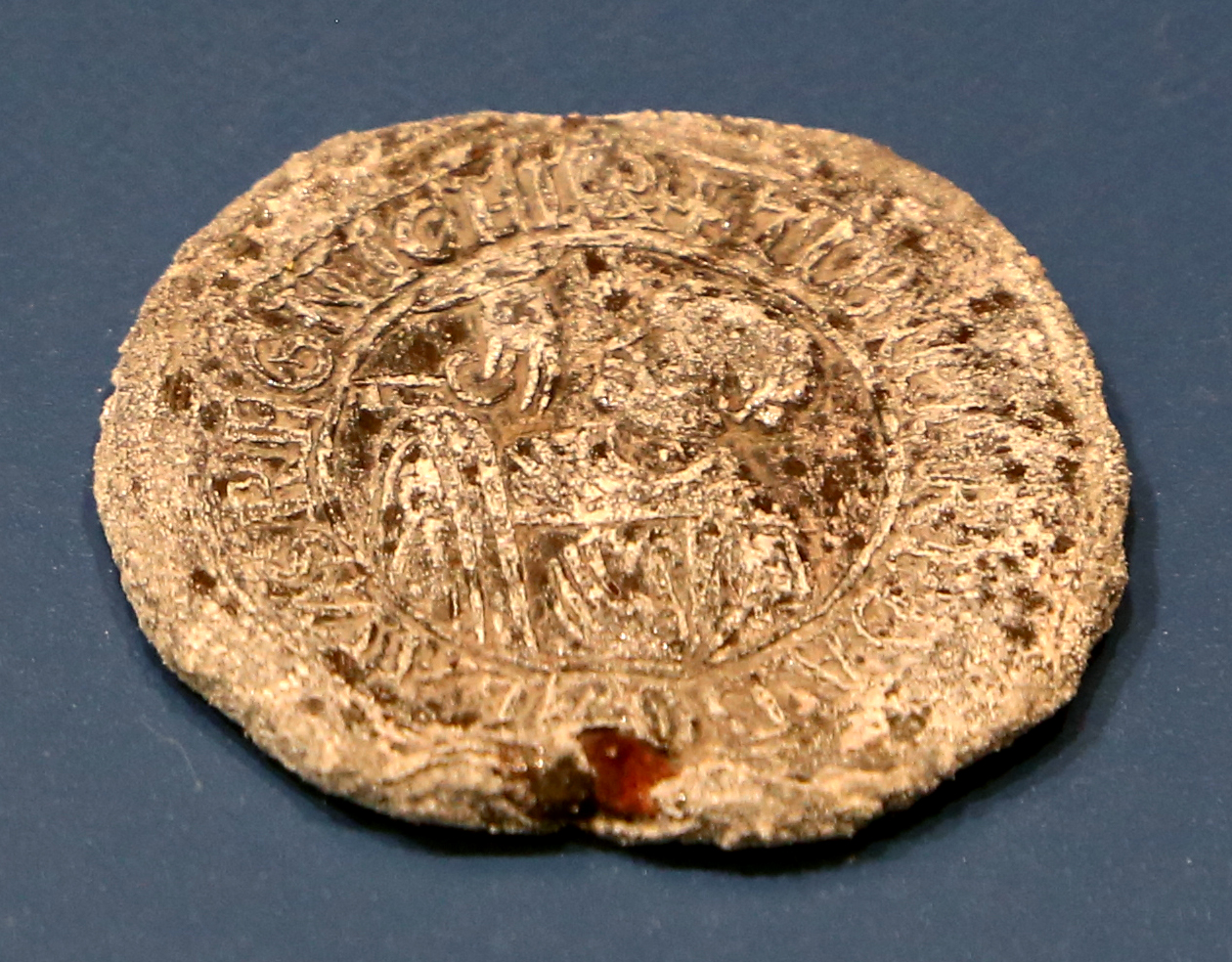|
1059 Births
Year 1059 ( MLIX) was a common year starting on Friday (link will display the full calendar) of the Julian calendar. Events By place Byzantine Empire * November 22 – Emperor Isaac I Komnenos falls ill on a hunt and retires to a monastery after a 2-year reign. He abdicates the Byzantine throne and appoints Constantine X, a Paphlagonian nobleman, as his successor. * Fall – The Magyars cross the Danube River, together with several Pecheneg tribes, but are halted by Byzantine forces (approximate date). Europe * Peter Krešimir IV (the Great) is crowned king of Croatia and Dalmatia. His coronation is recognised by the Byzantine Empire who confirm him as the supreme ruler of the Dalmatian cites, i.e. over the Theme of Dalmatia – excluding the theme of Ragusa and the Duchy of Durazzo. * August 23 – Robert Guiscard, count of Apulia and Calabria, signs the Treaty of Melfi with Pope Nicholas II. Nicholas recognises the Norman conquest of southe ... [...More Info...] [...Related Items...] OR: [Wikipedia] [Google] [Baidu] |
Robert Guiscard (by Merry-Joseph Blondel)
Robert Guiscard (; Modern ; – 17 July 1085) was a Norman adventurer remembered for the conquest of southern Italy and Sicily. Robert was born into the Hauteville family in Normandy, went on to become count and then duke of Apulia and Calabria (1057–1059), Duke of Sicily (1059–1085), and briefly prince of Benevento (1078–1081) before returning the title to the papacy. His sobriquet, in contemporary Latin and Old French , is often rendered "the Resourceful", "the Cunning", "the Wily", "the Fox", or "the Weasel". In Italian sources he is often Roberto II Guiscardo or Roberto d'Altavilla (from Robert de Hauteville), while medieval Arabic sources call him simply ''Abārt al-dūqa'' (Duke Robert). Background From 999 to 1042 the Normans in Italy, coming first as pilgrims, were mainly mercenaries serving at various times the Byzantines and a number of Lombard nobles. The first of the independent Norman lords was Rainulf Drengot who established himself in the fortress of Av ... [...More Info...] [...Related Items...] OR: [Wikipedia] [Google] [Baidu] |
Durrës
Durrës ( , ; sq-definite, Durrësi) is the second most populous city of the Republic of Albania and seat of Durrës County and Durrës Municipality. It is located on a flat plain along the Albanian Adriatic Sea Coast between the mouths of the Erzen and Ishëm at the southeastern corner of the Adriatic Sea. Durrës' climate is profoundly influenced by a seasonal Mediterranean climate. Durrës was founded by Ancient Greek colonists from Corinth and Corcyra under the name of Epidamnos around the 7th century BC in cooperation with the local Illyrian Taulantii. Also known as Dyrrachium, Durrës essentially developed as it became an integral part of the Roman Empire and its successor the Byzantine Empire. The Via Egnatia, the continuation of the Via Appia, started in the city and led across the interior of the Balkan Peninsula to Constantinople in the east. In the Middle Ages, Durrës was contested between Bulgarian, Venetian and Ottoman dominions. The Ottomans ultimatel ... [...More Info...] [...Related Items...] OR: [Wikipedia] [Google] [Baidu] |
Turkey
Turkey ( tr, Türkiye ), officially the Republic of Türkiye ( tr, Türkiye Cumhuriyeti, links=no ), is a list of transcontinental countries, transcontinental country located mainly on the Anatolia, Anatolian Peninsula in Western Asia, with a East Thrace, small portion on the Balkans, Balkan Peninsula in Southeast Europe. It shares borders with the Black Sea to the north; Georgia (country), Georgia to the northeast; Armenia, Azerbaijan, and Iran to the east; Iraq to the southeast; Syria and the Mediterranean Sea to the south; the Aegean Sea to the west; and Greece and Bulgaria to the northwest. Cyprus is located off the south coast. Turkish people, Turks form the vast majority of the nation's population and Kurds are the largest minority. Ankara is Turkey's capital, while Istanbul is its list of largest cities and towns in Turkey, largest city and financial centre. One of the world's earliest permanently Settler, settled regions, present-day Turkey was home to important Neol ... [...More Info...] [...Related Items...] OR: [Wikipedia] [Google] [Baidu] |
Sebasteia (theme)
The Theme of Sebasteia ( el, θέμα Σεβαστείας) was a military-civilian province (''thema'' or theme) of the Byzantine Empire located in northeastern Cappadocia and Armenia Minor, in modern Turkey. It was established as a theme in 911 and endured until its fall to the Seljuk Turks in the aftermath of the Battle of Manzikert in 1071. History The theme was formed around the city of Sebasteia (modern Sivas). The region formed part of the Armeniac Theme from the mid-7th century.. The theme is not mentioned in any source prior to the 10th century. In 908, Sebasteia appears for the first time as a distinct fortified frontier district ('' kleisoura''), and by 911 it had been raised to the status of a full theme. As a ''kleisoura'', it was probably subordinate of the newly established theme of Charsianon. The theme comprised the entirety of the Byzantine frontier regions along the middle course of the northern Euphrates. With the expansion of the Byzantine frontier, it was ext ... [...More Info...] [...Related Items...] OR: [Wikipedia] [Google] [Baidu] |
Kızılırmak River
The Kızılırmak (, Turkish for "Red River"), once known as the Halys River ( grc, Ἅλυς) and Alis River ( hy, Ալիս), is the longest river flowing entirely within Turkey. It is a source of hydroelectric power and is not used for navigation. Geography The Kızılırmak flows for a total of , rising in Eastern Anatolia around , flowing first to the west and southwest until , then forming a wide arch, the "Halys bend", flowing first to the west, then to the northwest, passing to the northeast of Lake Tuz (''Tuz Gölü'' in Turkish), then to the north and northeast, where it is joined by its major tributary, the Delice River (once known in Greek as the Cappadox river) at . After zigzagging to the northwest to the confluence with the Devrez River at , and back to the northeast, it joins the Gökırmak (''Blue River'' in Turkish) before finally flowing via a wide delta into the Black Sea east of Samsun at . There are dams on the river at Boyabat, Altınkaya and Derben ... [...More Info...] [...Related Items...] OR: [Wikipedia] [Google] [Baidu] |
Greater Khorasan
Greater Khorāsān,Dabeersiaghi, Commentary on Safarnâma-e Nâsir Khusraw, 6th Ed. Tehran, Zavvâr: 1375 (Solar Hijri Calendar) 235–236 or Khorāsān ( pal, Xwarāsān; fa, خراسان ), is a historical eastern region in the Iranian Plateau between Western and Central Asia. The name ''Khorāsān'' is Persian and means "where the sun arrives from" or "the Eastern Province".Sykes, M. (1914). "Khorasan: The Eastern Province of Persia". ''Journal of the Royal Society of Arts'', 62(3196), 279-286.A compound of ''khwar'' (meaning "sun") and ''āsān'' (from ''āyān'', literally meaning "to come" or "coming" or "about to come"). Thus the name ''Khorasan'' (or ''Khorāyān'' ) means "sunrise", viz. " Orient, East"Humbach, Helmut, and Djelani Davari, "Nāmé Xorāsān", Johannes Gutenberg-Universität Mainz; Persian translation by Djelani Davari, published in Iranian Languages Studies Website. MacKenzie, D. (1971). ''A Concise Pahlavi Dictionary'' (p. 95). London: Oxford University ... [...More Info...] [...Related Items...] OR: [Wikipedia] [Google] [Baidu] |
Chaghri Beg
Abu Suleiman Dawud Chaghri Beg ibn Mikail, widely known simply as Chaghri Beg (989–1060), ''Da'ud b. Mika'il b. Saljuq'', also spelled Chaghri, was the co-ruler of the early Seljuk Empire. The name ''Chaghri'' is Turkic (Çağrı in modern Turkish) and literally means "small falcon", "merlin". Background Chaghri and his brother Tughril were the sons of Mikail and the grandsons of Seljuk. The Great Seljuk Empire was named after the latter, who was a Turkic clan leader either in Khazar or Oghuz states. In the early years of the 11th century, they left their former home and moved near the city of Jend (now a village) by the Syr Darya river, where they accepted the suzerainty of the Karakhanids in Transoxania (roughly modern Uzbekistan and southern Kazakhstan). After the defeat of the Karakhanids by Ghaznavids, they were able to gain independence. Biography Very little is known of Chaghri and Tughril's lives until 1025. Both were raised by their grandfather Seljuk until they ... [...More Info...] [...Related Items...] OR: [Wikipedia] [Google] [Baidu] |
Alp Arslan
Alp Arslan was the second Sultan of the Seljuk Empire and great-grandson of Seljuk, the eponymous founder of the dynasty. He greatly expanded the Seljuk territory and consolidated his power, defeating rivals to the south and northwest, and his victory over the Byzantines at the Battle of Manzikert, in 1071, ushered in the Turkoman settlement of Anatolia. "But the Battle of Manzikert opened Asia Minor to Turkmen conquest" For his military prowess and fighting skills, he obtained the name ''Alp Arslan'', which means "Heroic Lion" in Turkish. Early life Alp Arslan was the son of Chaghri and nephew of Tughril, the founding Sultans of the Seljuk Empire. His grandfather was Mikail, who in turn was the son of the warlord Seljuk. He was the father of numerous children, including Malik-Shah I and Tutush I. It is unclear who the mother or mothers of his children were. He was known to have been married at least twice. His wives included the widow of his uncle Tughril, a Kara-Khanid pr ... [...More Info...] [...Related Items...] OR: [Wikipedia] [Google] [Baidu] |
Sicily
(man) it, Siciliana (woman) , population_note = , population_blank1_title = , population_blank1 = , demographics_type1 = Ethnicity , demographics1_footnotes = , demographics1_title1 = Sicilian , demographics1_info1 = 98% , demographics1_title2 = , demographics1_info2 = , demographics1_title3 = , demographics1_info3 = , timezone1 = CET , utc_offset1 = +1 , timezone1_DST = CEST , utc_offset1_DST = +2 , postal_code_type = , postal_code = , area_code_type = ISO 3166 code , area_code = IT-82 , blank_name_sec1 = GDP (nominal) , blank_info_sec1 = €89.2 billion (2018) , blank1_name_sec1 = GDP per capita , blank1_info_sec1 ... [...More Info...] [...Related Items...] OR: [Wikipedia] [Google] [Baidu] |
Norman Conquest Of Southern Italy
The Norman conquest of southern Italy lasted from 999 to 1139, involving many battles and independent conquerors. In 1130, the territories in southern Italy united as the Kingdom of Sicily, which included the island of Sicily, the southern third of the Italian Peninsula (except Benevento, which was briefly held twice), the archipelago of Malta, and parts of North Africa. Itinerant Norman forces arrived in southern Italy as mercenaries in the service of Lombard and Byzantine factions, communicating news swiftly back home about opportunities in the Mediterranean. These groups gathered in several places, establishing fiefdoms and states of their own, uniting and elevating their status to ''de facto'' independence within 50 years of their arrival. Unlike the Norman Conquest of England (1066), which took a few years after one decisive battle, the conquest of southern Italy was the product of decades and a number of battles, few decisive. Many territories were conquered independ ... [...More Info...] [...Related Items...] OR: [Wikipedia] [Google] [Baidu] |
Pope Nicholas II
Pope Nicholas II ( la, Nicholaus II; c. 990/995 – 27 July 1061), otherwise known as Gerard of Burgundy, was the head of the Catholic Church and ruler of the Papal States from 24 January 1059 until his death in 27 July 1061. At the time of his election, he was bishop of Florence. During his Papacy, Nicholas II successfully expanded the influence of the papacy in Milan and southern Italy. He was also responsible for passing papal election reforms which resulted in greater papal influence in electing new Popes. Early life Gerard of Burgundy was born in Chevron, in what is now Savoy. He was canon at Liège. In 1046 he became bishop of Florence, where he restored the canonical life among the clergy of numerous churches.Weber, Nicholas. "Pope Nicholas II." The Catholic Encyclopedia Vol. 11. New York: ... [...More Info...] [...Related Items...] OR: [Wikipedia] [Google] [Baidu] |
Treaty Of Melfi
{{short description, Treaty of 1059 The Treaty of Melfi or Concordat of Melfi was signed on 23 August 1059 between Pope Nicholas II and the Norman princes Robert Guiscard and Richard I of Capua. Based on the terms of the accord, the Pope recognized the Norman conquest of Southern Italy. Moreover, the Pope recognized Robert Guiscard as Duke of Apulia and Calabria, and as Count of Sicily. See also * Battle of Civitate *List of treaties This list of treaties contains known agreements, pacts, peaces, and major contracts between states, armies, governments, and tribal groups. Before 1200 CE 1200–1299 1300–1399 1400–1499 1500–1599 1600–1699 1700–1799 ... External linksTimelines 1059 [...More Info...] [...Related Items...] OR: [Wikipedia] [Google] [Baidu] |
.jpg)




